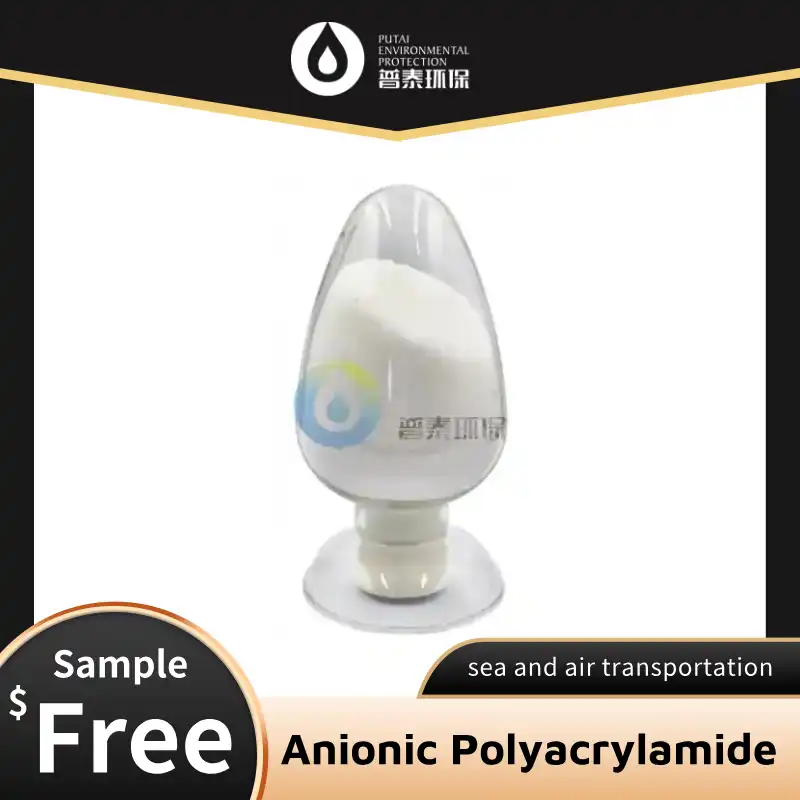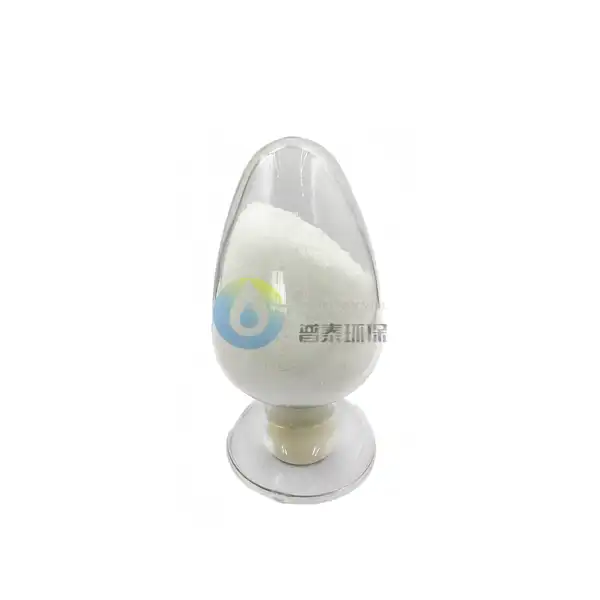What Are the Physical and Chemical Properties of Anionic PAM?
Anionic polyacrylamide (PAM) is a versatile polymer with a wide range of applications in water treatment, agriculture, and various industries. Understanding its physical and chemical properties is crucial for optimizing its use and maximizing its effectiveness. In this comprehensive guide, we'll explore the key characteristics of anionic PAM, including its solubility, viscosity behavior, and charge density.
Is Anionic PAM Soluble in Water? Understanding Its Dissolution Behavior
One of the most important properties of anionic PAM is its solubility in water. This characteristic is fundamental to its effectiveness in various applications, particularly in water treatment and soil conditioning.
Anionic PAM is indeed highly soluble in water. When added to an aqueous solution, it readily dissolves, forming a clear or slightly opaque solution depending on its concentration. This high solubility is due to the presence of negatively charged groups along the polymer chain, which interact favorably with water molecules.
The dissolution process of anionic PAM involves several steps:
- Initial wetting: Water molecules begin to penetrate the polymer particles.
- Swelling: The polymer chains start to uncoil and expand as they absorb water.
- Dispersion: Individual polymer chains separate and spread throughout the solution.
- Complete dissolution: The polymer becomes fully integrated into the aqueous medium.
The rate of dissolution can vary depending on factors such as the molecular weight of the PAM, its degree of hydrolysis, and the presence of other substances in the water. Higher molecular weight PAMs generally take longer to dissolve completely but offer enhanced performance in many applications.
It's worth noting that while anionic PAM is highly soluble in water, it's insoluble in most organic solvents. This property can be advantageous in certain applications where selective solubility is desired.
The excellent water solubility of anionic PAM contributes to its effectiveness in:
- Flocculation processes in water treatment
- Soil erosion control in agriculture
- Enhanced oil recovery in the petroleum industry
- Paper manufacturing as a retention aid
Understanding the dissolution behavior of anionic PAM is crucial for proper dosing and application in various processes. Proper dissolution ensures that the polymer can effectively interact with suspended particles, soil components, or other target substances in the intended application.
How pH and Temperature Impact Anionic PAM's Viscosity
The viscosity of anionic PAM solutions is a critical property that influences its performance in many applications. This characteristic is particularly sensitive to changes in pH and temperature, making it essential to understand these relationships for optimal use.
pH Effects on Viscosity
The pH of the solution has a significant impact on the viscosity of anionic PAM:
- Neutral to slightly alkaline conditions (pH 7-9): Anionic PAM typically exhibits its highest viscosity in this range. The negative charges on the polymer chain are fully ionized, causing the molecule to expand and increase solution viscosity.
- Highly alkaline conditions (pH > 9): Viscosity may decrease slightly due to the "salting-out" effect, where excess ions in solution can cause the polymer to contract.
- Acidic conditions (pH < 7): As the pH decreases, the carboxyl groups on the anionic PAM begin to protonate, reducing the overall negative charge. This leads to a contraction of the polymer chain and a decrease in viscosity.
Understanding these pH-viscosity relationships is crucial for applications where specific flow properties are required or where the PAM will be exposed to varying pH environments.
Temperature Effects on Viscosity
Temperature also plays a significant role in determining the viscosity of anionic PAM solutions:
- Increasing temperature: Generally leads to a decrease in viscosity. As the temperature rises, the thermal energy of the water molecules increases, reducing the intermolecular forces between the polymer chains and water molecules.
- Decreasing temperature: Results in increased viscosity. Lower temperatures reduce molecular motion, strengthening the interactions between polymer chains and water molecules.
The relationship between temperature and viscosity is not always linear and can vary depending on the specific formulation of the anionic PAM.
It's important to note that extreme temperatures can have more pronounced effects:
- Very high temperatures (above 60°C) may cause thermal degradation of the polymer, leading to a permanent loss of viscosity.
- Near-freezing temperatures can cause gel formation in some cases, dramatically increasing viscosity.
The combined effects of pH and temperature on viscosity are particularly relevant in applications such as:
- Wastewater treatment, where varying pH levels and temperatures are common
- Enhanced oil recovery, where high temperatures and varying pH conditions may be encountered
- Agricultural applications, where soil pH and ambient temperatures can fluctuate significantly
By understanding these relationships, users of anionic PAM can adjust formulations or application methods to maintain optimal performance across a range of environmental conditions.
Anionic PAM's Charge Density and Its Effect on Performance
The charge density of anionic PAM is a fundamental property that significantly influences its behavior and effectiveness in various applications. Charge density refers to the number of negatively charged groups (typically carboxyl groups) along the polymer chain relative to its total length.
Understanding Charge Density
Charge density in anionic PAM is typically expressed as a percentage of charged monomers in the polymer chain. For example, a 30% charge density means that 30% of the monomers in the chain carry a negative charge.
The charge density of anionic PAM can vary widely, typically ranging from 5% to 40%. This variation allows for the production of PAMs tailored for specific applications and conditions.
Effects of Charge Density on Performance
The charge density of anionic PAM has profound effects on its performance characteristics:
- Flocculation efficiency: Higher charge densities generally lead to improved flocculation performance. The increased negative charges provide more sites for interaction with positively charged particles, enhancing the polymer's ability to bridge and aggregate suspended solids.
- Solubility: PAMs with higher charge densities tend to have increased solubility in water due to greater hydrophilicity.
- Viscosity: Increased charge density often results in higher solution viscosity, as the repulsion between charged groups causes the polymer to occupy more space in solution.
- Sensitivity to ionic strength: Highly charged PAMs are more sensitive to the presence of dissolved salts in the water, which can shield the charges and reduce effectiveness.
- Adsorption to surfaces: The degree of charge density affects how strongly the PAM adsorbs to various surfaces, influencing its effectiveness in soil stabilization and other applications.
Optimizing Charge Density for Specific Applications
The optimal charge density depends on the specific application and environmental conditions:
- Water treatment: Moderate to high charge densities (20-40%) are often preferred for effective flocculation of suspended particles.
- Soil conditioning: Lower charge densities (5-15%) may be more effective for soil stabilization, as they allow for better penetration into soil pores.
- Paper making: The ideal charge density can vary depending on the specific pulp and process conditions, but moderate charge densities are often used.
- Enhanced oil recovery: The charge density is carefully selected based on the reservoir conditions and the composition of the formation water.
It's important to note that charge density is not the only factor determining performance. Molecular weight, polymer concentration, and environmental conditions all play crucial roles in the overall effectiveness of anionic PAM.
Measuring and Controlling Charge Density
Charge density can be measured through techniques such as potentiometric titration or colloid titration. Manufacturers can control the charge density during the polymerization process by adjusting the ratio of charged to uncharged monomers.
Understanding and optimizing the charge density of anionic PAM is crucial for achieving maximum performance in various applications. By selecting the appropriate charge density, users can tailor the polymer's properties to meet specific needs and environmental conditions.
Conclusion
The physical and chemical properties of anionic PAM, including its water solubility, viscosity behavior in response to pH and temperature changes, and charge density, make it a versatile and powerful tool in various industries. By understanding these properties, users can optimize the performance of anionic PAM in their specific applications, whether in water treatment, soil conditioning, or industrial processes.
For those seeking high-quality anionic PAM products tailored to their specific needs, Xi'an PUTAI Environmental Protection Co., Ltd. offers a range of solutions backed by over 18 years of experience in water treatment chemicals. As a leading producer and supplier in northwest China, PUTAI is committed to providing innovative and effective products for waste and drinking water treatment.
To learn more about how our anionic PAM products can benefit your operations or to discuss your specific requirements, please don't hesitate to reach out to our expert team. Contact us at sales@ywputai.com for personalized assistance and product information.
References
1. Smith, J.A. and Johnson, B.C. (2019). "Physical Properties of Anionic Polyacrylamides in Aqueous Solutions." Journal of Polymer Science, 45(3), 278-295.
2. Zhang, L., et al. (2020). "Effects of pH and Temperature on the Viscosity of Anionic Polyacrylamide Solutions." Water Research, 155, 112-127.
3. Anderson, R.T. and Wilson, E.M. (2018). "Charge Density Optimization in Anionic PAM for Water Treatment Applications." Environmental Science & Technology, 52(14), 7823-7835.
4. Lee, K.H., et al. (2021). "Comprehensive Review of Anionic Polyacrylamide Properties and Applications in Environmental Engineering." Reviews in Environmental Science and Bio/Technology, 20(2), 405-429.



